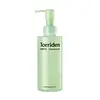What's inside
What's inside
 Key Ingredients
Key Ingredients

No key ingredients
 Benefits
Benefits

 Concerns
Concerns

 Ingredients Side-by-side
Ingredients Side-by-side

Water
Skin ConditioningGlycerin
HumectantSodium Cocoyl Alaninate
Lauryl Glucoside
CleansingLauryl Hydroxysultaine
CleansingCoco-Betaine
CleansingDisodium Cocoamphodiacetate
CleansingCentella Asiatica Extract
CleansingMadecassoside
AntioxidantAsiaticoside
AntioxidantAsiatic Acid
Skin ConditioningMadecassic Acid
Skin ConditioningPanthenol
Skin ConditioningCapryloyl Salicylic Acid
ExfoliatingCeramide NP
Skin ConditioningAllantoin
Skin ConditioningHamamelis Virginiana Extract
AntiseborrhoeicAlthaea Rosea Flower Extract
Skin ConditioningNymphaea Caerulea Flower Extract
Skin ConditioningSwertia Japonica Extract
Skin ConditioningLactobacillus Ferment
Skin ConditioningGlycine Soja Seed Extract
Skin ConditioningQuillaja Saponaria Bark Extract
CleansingAloe Ferox Leaf Extract
Skin ConditioningButylene Glycol
HumectantPentylene Glycol
Skin ConditioningHexylene Glycol
EmulsifyingCoco-Glucoside
CleansingSodium Chloride
MaskingSodium Cocoyl Isethionate
CleansingCaprylyl Glycol
EmollientCaprylic/Capric Triglyceride
MaskingOctanediol
Acrylates/C10-30 Alkyl Acrylate Crosspolymer
Emulsion StabilisingHydrogenated Lecithin
EmulsifyingMelia Azadirachta Leaf Extract
Skin ConditioningMelia Azadirachta Flower Extract
Skin ConditioningDipotassium Glycyrrhizate
HumectantCitric Acid
Buffering1,2-Hexanediol
Skin ConditioningRosmarinus Officinalis Leaf Oil
MaskingEthylhexylglycerin
Skin ConditioningWater, Glycerin, Sodium Cocoyl Alaninate, Lauryl Glucoside, Lauryl Hydroxysultaine, Coco-Betaine, Disodium Cocoamphodiacetate, Centella Asiatica Extract, Madecassoside, Asiaticoside, Asiatic Acid, Madecassic Acid, Panthenol, Capryloyl Salicylic Acid, Ceramide NP, Allantoin, Hamamelis Virginiana Extract, Althaea Rosea Flower Extract, Nymphaea Caerulea Flower Extract, Swertia Japonica Extract, Lactobacillus Ferment, Glycine Soja Seed Extract, Quillaja Saponaria Bark Extract, Aloe Ferox Leaf Extract, Butylene Glycol, Pentylene Glycol, Hexylene Glycol, Coco-Glucoside, Sodium Chloride, Sodium Cocoyl Isethionate, Caprylyl Glycol, Caprylic/Capric Triglyceride, Octanediol, Acrylates/C10-30 Alkyl Acrylate Crosspolymer, Hydrogenated Lecithin, Melia Azadirachta Leaf Extract, Melia Azadirachta Flower Extract, Dipotassium Glycyrrhizate, Citric Acid, 1,2-Hexanediol, Rosmarinus Officinalis Leaf Oil, Ethylhexylglycerin
Water
Skin ConditioningPropylene Glycol
HumectantLauroyl/Myristoyl Methyl Glucamide
EmollientCetearyl Alcohol
EmollientGlyceryl Stearate Se
EmulsifyingEthylhexyl Palmitate
EmollientOctyldodecanol
EmollientCeteareth-25
CleansingPalmitic Acid
EmollientStearic Acid
CleansingGlycerin
HumectantAloe Barbadensis Leaf Extract
EmollientMaltodextrin
AbsorbentParfum
MaskingAllantoin
Skin ConditioningXanthan Gum
EmulsifyingLactic Acid
BufferingMethylchloroisothiazolinone
PreservativeMethylisothiazolinone
PreservativeWater, Propylene Glycol, Lauroyl/Myristoyl Methyl Glucamide, Cetearyl Alcohol, Glyceryl Stearate Se, Ethylhexyl Palmitate, Octyldodecanol, Ceteareth-25, Palmitic Acid, Stearic Acid, Glycerin, Aloe Barbadensis Leaf Extract, Maltodextrin, Parfum, Allantoin, Xanthan Gum, Lactic Acid, Methylchloroisothiazolinone, Methylisothiazolinone
 Reviews
Reviews

Ingredients Explained
These ingredients are found in both products.
Ingredients higher up in an ingredient list are typically present in a larger amount.
Allantoin is a soothing ingredient known for its protective and moisturizingg properties. Because of this, it is often added to products with strong active ingredients.
Studies show higher concentrations of this ingredient can promote wound healing.
Though it can be derived from the comfrey plant, allantoin is produced synthetically for cosmetic products to ensure purity.
Learn more about AllantoinGlycerin is already naturally found in your skin. It helps moisturize and protect your skin.
A study from 2016 found glycerin to be more effective as a humectant than AHAs and hyaluronic acid.
As a humectant, it helps the skin stay hydrated by pulling moisture to your skin. The low molecular weight of glycerin allows it to pull moisture into the deeper layers of your skin.
Hydrated skin improves your skin barrier; Your skin barrier helps protect against irritants and bacteria.
Glycerin has also been found to have antimicrobial and antiviral properties. Due to these properties, glycerin is often used in wound and burn treatments.
In cosmetics, glycerin is usually derived from plants such as soybean or palm. However, it can also be sourced from animals, such as tallow or animal fat.
This ingredient is organic, colorless, odorless, and non-toxic.
Glycerin is the name for this ingredient in American English. British English uses Glycerol/Glycerine.
Learn more about GlycerinWater. It's the most common cosmetic ingredient of all. You'll usually see it at the top of ingredient lists, meaning that it makes up the largest part of the product.
So why is it so popular? Water most often acts as a solvent - this means that it helps dissolve other ingredients into the formulation.
You'll also recognize water as that liquid we all need to stay alive. If you see this, drink a glass of water. Stay hydrated!
Learn more about Water